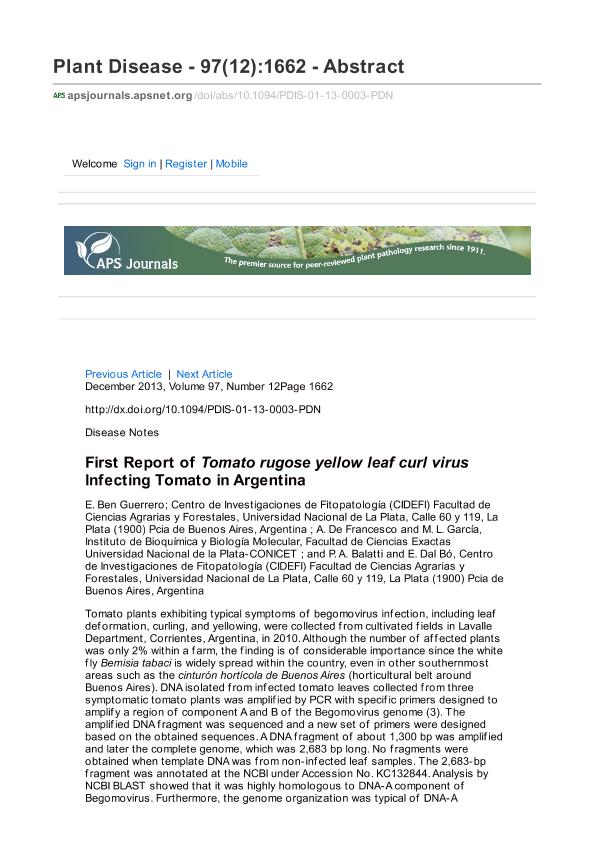Mostrar el registro sencillo del ítem
dc.contributor.author
Ben Guerrero, Emiliano

dc.contributor.author
de Francesco, Agustina

dc.contributor.author
García, M. L.
dc.contributor.author
Balatti, Pedro Alberto

dc.contributor.author
Dal Bó, Elena

dc.date.available
2022-12-16T15:20:08Z
dc.date.issued
2013-11
dc.identifier.citation
Ben Guerrero, Emiliano; de Francesco, Agustina; García, M. L.; Balatti, Pedro Alberto; Dal Bó, Elena; First report of tomato rugose yellow leaf curl virus infecting tomato in Argentina; American Phytopathological Society; Plant Disease; 97; 12; 11-2013; 1662-1662
dc.identifier.issn
0191-2917
dc.identifier.uri
http://hdl.handle.net/11336/181532
dc.description.abstract
Tomato plants exhibiting typical symptoms of begomovirus infection, including leaf deformation, curling, and yellowing, were collected from cultivated fields in Lavalle Department, Corrientes, Argentina, in 2010. Although the number of affected plants was only 2% within a farm, the finding is of considerable importance since the white fly Bemisia tabaci is widely spread within the country, even in other southernmost areas such as the cinturón hortícola de Buenos Aires (horticultural belt around Buenos Aires). DNA isolated from infected tomato leaves collected from three symptomatic tomato plants was amplified by PCR with specific primers designed to amplify a region of component A and B of the Begomovirus genome (3). The amplified DNA fragment was sequenced and a new set of primers were designed based on the obtained sequences. A DNA fragment of about 1,300 bp was amplified and later the complete genome, which was 2,683 bp long. No fragments were obtained when template DNA was from non-infected leaf samples. The 2,683-bp fragment was annotated at the NCBI under Accession No. KC132844. Analysis by NCBI BLAST showed that it was highly homologous to DNA-A component of Begomovirus. Furthermore, the genome organization was typical of DNA-A component of bipartite New World begomovirus. The sequence had one open reading frame (ORF) on the viral-sense strand (AV1/CP) and four ORFs on the complementary-sense strand (AC1/Rep, AC2/TrAp, AC3/REn, and AC4). In order to confirm this finding, the viral genome was amplified by rolling circle amplification (RCA, TempliPhi 100 Amplification Kit, Amersham Biosciences) as described by the manufacturer instructions. The RCA full-length product was digested with XhoI generating a 2,700-bp DNA fragment, suggesting the presence of only one restriction site, in agreement with the bioinformatics analysis of the KC132844 sequence. This PCR product was used as template in PCR reactions with specific primers to DNA-A or DNA-B components. While the DNA-A primers generated the expected 1,300-bp fragment, those homologous to the DNA-B component did not generate amplifications. These results confirmed the identity of the DNA-A component of the isolate MT8. The full sequence of the DNA-A component was 94% homologous to the DNA-A sequence of the Uruguayan begomovirus Tomato Rugose Yellow Leaf Curl Virus-[U4.1] (JN381823.1). Therefore, considering our results and the criteria proposed by Fauquet (1), isolate MT8 is a new species of begomovirus described recently (2). This is the first report of TRYLCV in one of the main areas of tomato production in Argentina. This virus might be accompanying another begomovirus TYVSV that provoked yellow veins symptoms in tomato plants cultivated in the same area of Corrientes. These viruses appeared recently and concomitantly with the introduction of the white fly Bemisia spp. in the area, which is one of the main production areas of tomato and provides fresh tomatoes to the whole country, and in wintertime to the city of Buenos Aires, when the horticultural belt around Buenos Aires is not under production.
dc.format
application/pdf
dc.language.iso
eng
dc.publisher
American Phytopathological Society

dc.rights
info:eu-repo/semantics/openAccess
dc.rights.uri
https://creativecommons.org/licenses/by-nc-sa/2.5/ar/
dc.subject
BEGOMOVIRUS
dc.subject
TOMATO
dc.subject
TOMATO RUGOSE YELLOW LEAF CURL VIRUS
dc.subject.classification
Virología

dc.subject.classification
Ciencias Biológicas

dc.subject.classification
CIENCIAS NATURALES Y EXACTAS

dc.title
First report of tomato rugose yellow leaf curl virus infecting tomato in Argentina
dc.type
info:eu-repo/semantics/article
dc.type
info:ar-repo/semantics/artículo
dc.type
info:eu-repo/semantics/publishedVersion
dc.date.updated
2022-12-07T17:58:26Z
dc.journal.volume
97
dc.journal.number
12
dc.journal.pagination
1662-1662
dc.journal.pais
Estados Unidos

dc.description.fil
Fil: Ben Guerrero, Emiliano. Universidad Nacional de La Plata. Facultad de Ciencias Agrarias y Forestales. Departamento de Ciencias Biológicas. Centro de Investigaciones de Fitopatología. Provincia de Buenos Aires. Gobernación. Comisión de Investigaciones Científicas. Centro de Investigaciones de Fitopatología; Argentina
dc.description.fil
Fil: de Francesco, Agustina. Consejo Nacional de Investigaciones Científicas y Técnicas. Centro Científico Tecnológico Conicet - La Plata. Instituto de Biotecnología y Biología Molecular. Universidad Nacional de La Plata. Facultad de Ciencias Exactas. Instituto de Biotecnología y Biología Molecular; Argentina
dc.description.fil
Fil: García, M. L.. Consejo Nacional de Investigaciones Científicas y Técnicas. Centro Científico Tecnológico Conicet - La Plata. Instituto de Biotecnología y Biología Molecular. Universidad Nacional de La Plata. Facultad de Ciencias Exactas. Instituto de Biotecnología y Biología Molecular; Argentina
dc.description.fil
Fil: Balatti, Pedro Alberto. Universidad Nacional de La Plata. Facultad de Ciencias Agrarias y Forestales. Departamento de Ciencias Biológicas. Centro de Investigaciones de Fitopatología. Provincia de Buenos Aires. Gobernación. Comisión de Investigaciones Científicas. Centro de Investigaciones de Fitopatología; Argentina
dc.description.fil
Fil: Dal Bó, Elena. Universidad Nacional de La Plata. Facultad de Ciencias Agrarias y Forestales. Departamento de Ciencias Biológicas. Centro de Investigaciones de Fitopatología. Provincia de Buenos Aires. Gobernación. Comisión de Investigaciones Científicas. Centro de Investigaciones de Fitopatología; Argentina
dc.journal.title
Plant Disease

dc.relation.alternativeid
info:eu-repo/semantics/altIdentifier/url/http://apsjournals.apsnet.org/doi/abs/10.1094/PDIS-01-13-0003-PDN
dc.relation.alternativeid
info:eu-repo/semantics/altIdentifier/doi/https://doi.org/10.1094/PDIS-01-13-0003-PDN
Archivos asociados
